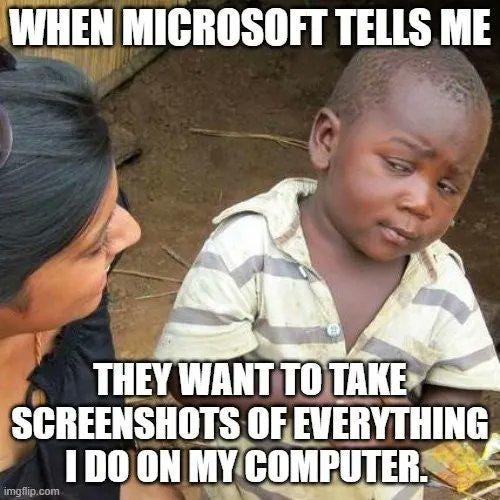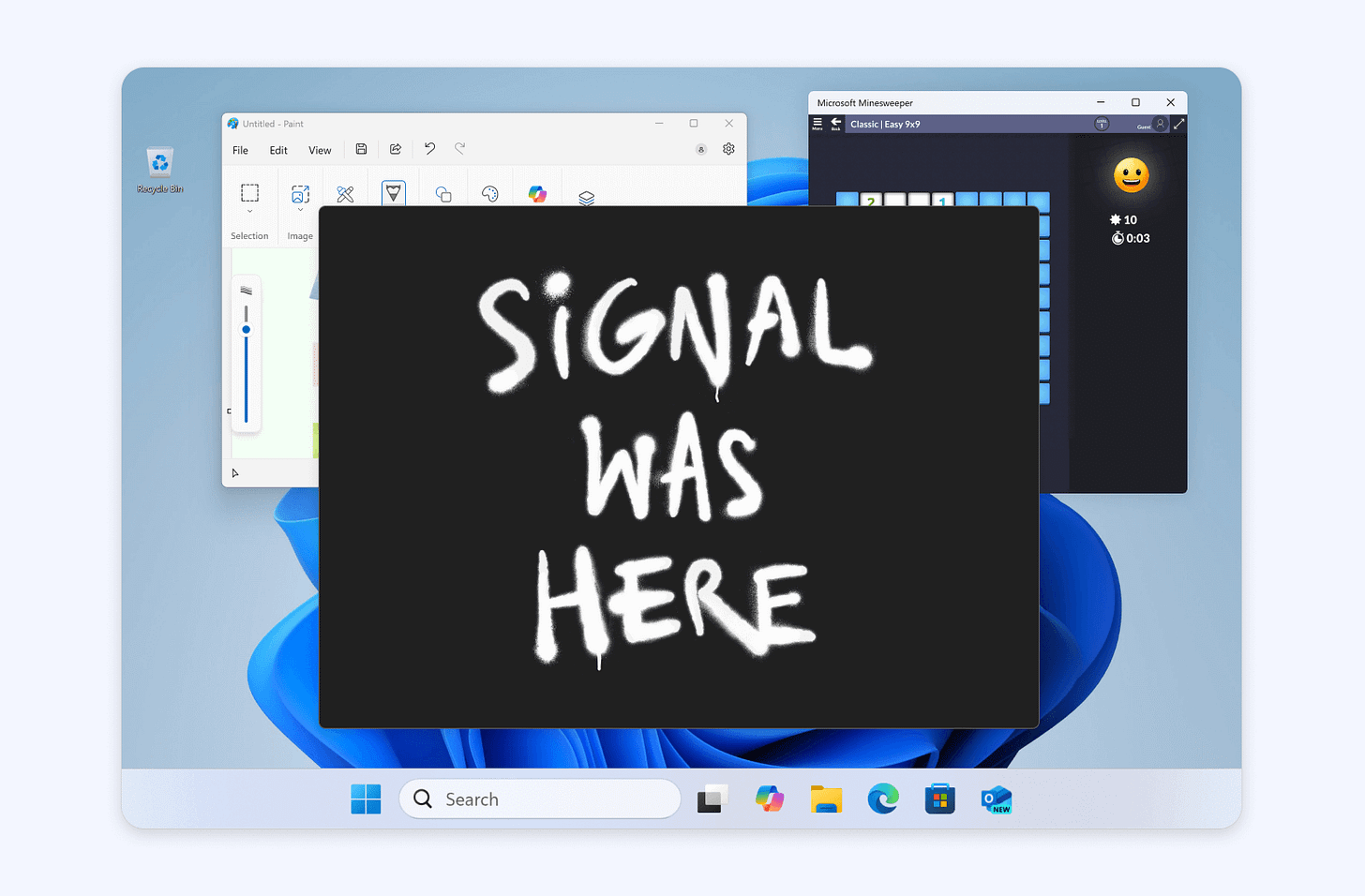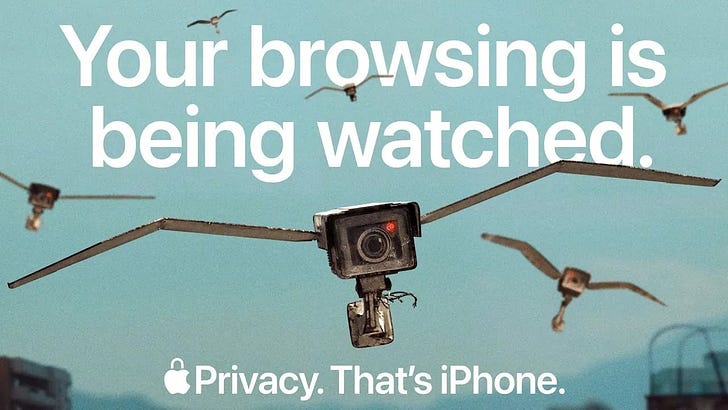Microsoft Windows Users: Beware This Growing Privacy Threat on Your Computer
The hidden screen capture feature putting your sensitive data at risk
TL;DR: Microsoft Recall is a new AI feature that takes screenshots of your screen every few seconds, storing them in a searchable database. This creates obvious privacy risks because sensitive data can be captured without your control. Signal Messenger is fighting back by blocking Recall from capturing chat windows using DRM-like protections. But Microsoft doesn’t offer users a way to disable Recall, and Windows remains a privacy challenge overall. Switching to Apple’s macOS may help, but it’s not a perfect solution. Readers may consider trying out non-Big Tech OS options like Linux (we discuss our experience revitalizing an old laptop with Linux Mint at the end).
What is Microsoft Recall (and why you should care)
Microsoft first announced Recall in May 2024 as part of its push to deeply integrate AI into Windows 11. The feature is designed to act like a “photographic memory” of your computer activity by automatically capturing screenshots of your entire screen every few seconds. These images are then stored in a centralized, searchable database, allowing you to quickly find past tasks, conversations, or documents by visually “looking back” at what you were doing.
While the idea sounds useful on the surface, the announcement triggered immediate public backlash. Privacy experts and users alike raised serious concerns about the implications of continuously capturing everything on users’ screens, including sensitive information like passwords, private chats, banking data, confidential work files, and more. Many pointed out that Recall’s data collection is broad, persistent, and operates without meaningful user consent or granular controls to limit what is captured.
We discussed this creepy feature one year ago:
Due to this intense criticism, Microsoft delayed Recall’s rollout to address some of the issues. When it finally reappeared, the feature was available exclusively on Windows 11, taking advantage of the OS’s advanced AI capabilities and cloud integration.
Some good news, Microsoft has not included Recall in Windows 10, nor announced plans to bring it there. More on why this matters later.
Despite Microsoft’s adjustments and reassurances, Recall still captures screen content continuously in the background, raising very real (not just theoretical) privacy risks. The data’s centralized storage and searchability create tempting targets for hackers or misuse. The lack of transparent controls means users have little say over what’s collected, how long it’s stored, or who can access it.
This makes Recall far more than a productivity feature; it’s a major privacy challenge for Windows 11 users that deserves serious attention.
Why Recall is a Real Privacy Risk
Recall isn’t a simple feature running on your device. It collects data continuously and centrally, without meaningful user control. If you open something sensitive, it’s captured. There’s no way to exclude specific apps or windows.
It’s also concerning that apps focused on privacy, like Signal Messenger, are vulnerable to Recall because it captures screen content regardless of encryption.
Because Recall stores so much private information in a searchable way, it creates a tempting target for attackers and a potential tool for internal misuse. It’s also a gold mine for law enforcement and the intelligence community.
The idea of taking continuous screenshots of your personal computer is so ridiculous and invasive, that we assume it was cooked up by the IC. But that’s a discussion for a different day. Our immediate concern is what to do about this since Windows is so widely used.
Can You Turn off Microsoft Recall?
As of publication, Microsoft does not provide a straightforward way to disable Recall. Unlike many privacy-sensitive features where users can toggle them on or off, Recall runs quietly in the background with no simple user control.
There is no on/off switch in Windows settings or in the Microsoft apps that use Recall. Some enterprise environments might have tools to limit or control it, but for most personal users, that option doesn’t exist.
Some users try to limit Recall by disabling related telemetry or AI services in Windows, but these steps are not guaranteed and could affect system functionality.
Because of this lack of user control, Recall raises real red flags about transparency and privacy rights.
How Signal Private Messenger Protects its Users on Windows 11
Signal has responded by enabling a “Screen security” feature on Signal Desktop for Windows 11. This blocks Recall from capturing screenshots of Signal chats by using Digital Rights Management (DRM) techniques, similar to how streaming apps prevent screenshotting movies.
If you try to take a screenshot of Signal with this enabled, you’ll just get a black screen.
This is far from perfect. It affects usability and accessibility, but it’s the best defense available because Microsoft doesn’t give developers better options to protect content from Recall.
Signal’s move highlights how little control users have over Recall’s screen capturing on Windows.
Is Switching to Apple a Better Option?
If you’re worried about Recall and Windows’ privacy issues, you might wonder if switching to Apple is safer.
Apple’s macOS and iOS have a stronger reputation for privacy and security. Apple tightly controls app permissions and limits background data collection. They also require apps to request permission for screen recording or capturing.
Currently, Apple doesn’t have an AI feature like Microsoft Recall that takes automatic screenshots of your entire screen. That’s a plus for privacy.
But Apple isn’t perfect. Their ecosystem collects data for services and personalized features, and they have been criticized for some data-sharing practices with third parties.
Overall, macOS is better for privacy ROI move than Windows, especially if you combine it with privacy-focused apps. But no platform is completely free from privacy risk. As we like to say, there is no perfect solution, only tradeoffs.
Why Windows is still a privacy challenge
Beyond Recall, Windows has long raised privacy concerns:
It collects extensive telemetry data with limited user control.
Many diagnostic and usage data settings can’t be fully disabled on consumer versions.
Built-in AI and cloud services increase data flowing to Microsoft.
Privacy settings are complex and often default to data sharing.
Recall fits this pattern of deep, persistent data collection with few user controls. It’s part of why Windows users face higher privacy risks by default.
What you can do today
While Microsoft Recall remains active with little user control, there are steps you can take to reduce your privacy exposure. These practical steps won’t eliminate all risks, but they will help in the aggregate.
Keep reading with a 7-day free trial
Subscribe to Secrets of Privacy to keep reading this post and get 7 days of free access to the full post archives.





